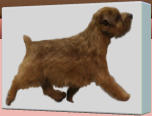

Breeders Corner

Kafka said, "All knowledge, the
totality of all questions and
answers, is contained in the dog."

Please submit your article,
publication or hyperlink to an
article to Judi Hartell.
DataDawg@Austin.rr.com
Submissions

Quote



The Bluebonnet Norfolk Terrier Club does not recommend,
guarantee, endorse, nor rate these recommendations or
contributors, their kennel or their stock. The purpose of this section
is to share the knowledge and experience of breeders who have vast
experience in whelping and raising puppies. The tips and tricks
below are intended to augment qualified veterinarian care, not as a
substitute for qualified veterinarian care of the dam and puppies.






SEX-LINKED RECESSIVE
(Hemophilia A, for instance, is a sex-linked recessive defect.)
1. On the average half the male offspring of a carrier dam are affected.
2. On the average half the female offspring of a carrier dam are carriers.
3. The trait may skip generations.
4. The pattern of transmission is often called oblique, because the gene goes from
phenotypically normal dams, to affected sons, and then to phenotypically normal carrier
daughters.
5. Affected males transmit the gene to all of their daughters and to none of their sons,
because the sons receive the Y- and not the X-chromosome.
6. If both parents are affected with the trait, all offspring are affected.
7. For an affected female offspring to emerge, the dam must be at least a carrier, and the
sire must be affected with the trait.
8. Most affected offspring in a typical pedigree are male.
9. There may be related affected males on the maternal side of the pedigree, but only
rarely (if ever) on the paternal side.
10. All male offspring of an affected female are affected with the trait when the sire is
normal, and all daughters are phenotypically normal carriers.
AUTOSOMAL DOMINANT
Some forms of epilepsy and deafness are autosomal dominant.
1. At least one parent of an affected offspring must show the trait.
2. The trait occurs in successive generations (no skipping).
3. Males and females are affected equally.
4. About 50% of the offspring of an affected parent will be affected.
Autosomal Recessive
PRA and brindle, for instance, are autosomal recessive traits.
1. Both parents are proven carriers, but generally show no phenotypic manifestation of
the trait.
2. The trait tends to occur in one generation and then skips one or two generations until
carrier descendants are again mated, allowing the genes to be expressed.
3. Males and females are affected equally.
4. Matings between carriers (heterozygotes) on the average produce 25% affected
(homozygous recessive), 50% carriers (heterozygous) and 25% that do not have the
mutant gene (homozygous dominant).


- Behavior
- Honor Roll
- Living With Norfolk Terriers
- Fun With Your Norfolk
- Tip Of The Week
- Publications
- Therapy and Service Dogs
- Health & Nutrition
- Competition


- Books
- Clubs
- Collectibles, Gifts & Fun Activities
- Companion Animal Recovery
- Dog Show Superintendents
- Genetics
- Health Related Sites
- Canine Health Links
- Vaccination Protocols
- Animal Health Trust
- Online Mendelian Inheritance In Animals
- Univ. Of Cambridge Vet. School
- Canine Inherited Disorders Database
- All Creatures Veterinary Hospital
- A First Aid Kit
- Veterinary Pet Insurance
- AKC Pet Health Plan
- Cornell Univ. College of Vet. Medicine
- More Health Related Sites
- Independent Sites
- Pet Travel
- Training Your Puppy
- Publications


- Breeding Tips
- Breeding Tips Page One
- Breeding Tips Page Two
- Breeding Tips Page Three
- Breeding Tips Page Four
- Breeding Tips Page Five
- Breeding Tips Page Six
- Virus &The Pregnant Bitch
- Dog Neutering Video
- Vaccinations & The Pregnant Bitch
- Incontinence In The Pregnant Bitch
- Flagyl & The Pregnant Bitch
- Canine Reproduction
- Frozen vs Chilled Semen
- Modern Breeding Management
- Dialogue On Rasberry Leaves
- Monitoring Pregnancy
- Uses For Vaginal Cultures
- OFA & The Pregnant Bitch
- Breeding Tips Page Seven
- Breeding Tips Page Eight
- Breeding Tips Page Nine
- Breeding Tips Page Ten
- Breeding Tips Page Eleven
- Breeding Tips Page Twelve
- Breeding Tips Page Thirteen
- Breeding Tips Page Fourteen
- Genetics And Inheritance
- Rescue









